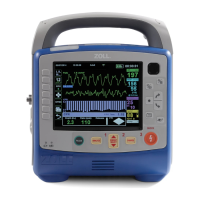Chapter 10 Pulse CO-Oximetry (SpO2)
10-6 www.zoll.com 9650-001355-01 Rev. M
• Electrical Shock Hazard: Carry out periodic tests to verify that leakage currents of patient-
applied circuits and the system are within acceptable limits as specified by the applicable
safety standards. The summation of leakage currents must be checked and in compliance
with IEC 60601-1 and UL60601-1. The system leakage current must be checked when
connecting external equipment to the system. When an event such as a component drop of
approximately 1 meter or greater or a spillage of blood or other liquids occurs, retest before
further use. Injury to personnel could occur.
• Disposal of product - Comply with local laws in the disposal of the instrument and/or its
accessories.
• To minimize radio interference, other electrical equipment that emits radio frequency
transmissions should not be in close proximity to the pulse co-oximeter.
SpO
2
Setup and Use
To take accurate SpO
2
measurements using the X Series unit, you must perform the following
steps, each of which corresponds to a section in this chapter.
1. Select the correct sensor.
2. Apply the sensor to the patient.
3. Connect the sensor to the X Series unit.
4. Configure alarms and settings (if the current alarms and settings are not appropriate).
Pulse oximetry measurements begin as soon as the sensor is applied to the patient and
connected to the X Series unit.
Selecting the SpO
2
Sensor
When selecting the sensor, consider the patient’s weight, the adequacy of perfusion, the
available sensor sites, and the anticipated duration of monitoring. For more information, refer
to the Accessories section of this chapter, which provides a list of ZOLL-approved reusable and
single-use sensors for adult, pediatric, and neonate patients. Before applying the sensor, always
familiarize yourself with the Directions for Use that the manufacturer provides with the sensor.
Note: An SpHb sensor is required for measuring the optional SpHb and SpOC parameters.
The monitor does not display SpCO values when you use a SpHb sensor and does not
display SpHb values when you use a SpCO sensor.
Applying the SpO
2
Sensor
Choose a site that is well perfused and restricts a conscious patient's movements the least. The
ring finger or middle finger of the nondominant hand is preferred.
Alternatively, you can use the other digits on the nondominant hand. Be sure the sensor's
detector is fully covered by flesh. You can use the great toe or long toe (next to the great toe) on
restrained patients or patients whose hands are unavailable.
To prevent interference from ambient light, ensure that the sensor is properly applied, and cover
the sensor site with opaque material, if required. Failure to take this precaution in high ambient
light conditions may result in inaccurate measurements.
Do not select an SpO
2
sensor site on the same arm/leg as an NIBP cuff. Inflation of the cuff will
cause the SpO
2
values to read incorrectly.

